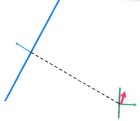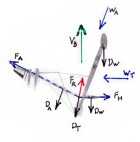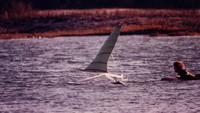High-Speed Sailing
| Vessel Name: | Sailien |
| Vessel Make/Model: | Experimental/custom |
28 September 2013
The America’s Cup
I watched, with interest, the videos of the 34th America’s Cup. At last we have fast sailboats engaged in a competition that is fun to watch. The virtual images (such as course boundaries, distance grid lines, separation between boats, etc.) overlaid on the real images really helps to keep the race [...]
31 August 2013
100 Knots for Hydroptere?
The latest news from Hydroptere is that they have plans for a 100 knot sailboat. This was posted on 26 Aug 2013, so look for that date at this address. http://hydroptere.com/en/the-news/last-news/
17 November 2012
Aptly named Sailrocket, blasts off!
While yet to be ratified, Sailrocket posted an average speed over 500 meters of 59 knots. I will not be surprised if they increase their record into the 60 knot range during this record attempt.
02 January 2012
More drag for VSR2?
I want to start by pointing out that the whole VSR2 team has done a stellar job and has demonstrated conclusively that the forces that drive a sailboat can be aligned for roll stability without using ballast and without using any down-force. (Trifoiler achieved roll stability by using down-force, but [...]
18 December 2011
My analysis of Sailrocket
I copied a diagram of VSR2 (wing doesn’t show well) and added in the major force arrows that apply. Be aware that these arrows are not correct in terms of scale (length) and some of their locations are guesses, however I believe I’m correct enough for us to learn something about what VSR2 has been [...]
23 October 2011
60 is within reach, what’s next?
I have been watching Sailrocket’s progress with great interest and there’s no question they have a winner. I fully expect to see them reach 60kt in the near future. Sailrocket has now demonstrated what I first learned with my models and again with my full-sized prototypes, that if you get the forces [...]
Pitch control
Sailrocket has an airfoil shaped cross-arm connecting the main hull to the lee planing pod which is designed to provide some life using surface-effect. They are also using a flap on the outboard end to provide lift to the lee pod. Now as the velocity increases, the lift increases and they generated enough lift to overcome the weight of the craft and flip. A new addition to the cross-arm is a flap next to the main hull that will be providing some down-force to keep the main hull on the water. (Refer to their website for photos of this.)
There have been suggestions that automatic controls should be used to control lift on the cross-arm and that appears to be the best solution, although it will be more complex and expensive to do. Ideally the cross-arm lift should be limited to a pre-determined amount, which is never exceeded. Probably the best example we have of this is Trifoiler, which has automatic pitch and roll control provided by the two surface sensors (skis). This system could be adapted to Sailrocket's cross-arm, but then the arm would have to rotate some to adjust angle of attack -- you see how this starts to get a bit complex. I prefer not to have sensors projecting out from the craft and have been exploring other ways to control any aerodynamic lift on Sailien.
One other thing to note for Sailrocket is the new curved main foil. They reported that the main foil had been flexing so the curved foil should handle that. Now when the load on the foil increases, it will flex straighter which will be correct.
If all goes well Sailrocket should be able to capture the outright record this time out. Good luck to the Sailrocket team.
Bob
About & Links
- Bob's Surfing Blog
- Bob's Website
- Greenbird (Windjet)
- l'Hydroptere
- Le Projet Dared
- Macquarie Speed Sailing Team
- Monofoil Sailing
- Mountain Goat STOL
- Mr Smith's Amazing Sailboats
- Patent Office (Search)
- Radboat
- Sailien Prototypes (early), Delta, etc.
- Sailien Video
- Sailien Website
- The Basics of Surfboard Design
- The Basics of Surfboard Design en Espanol
- The Swedish Speed-Sailing Challenge
- Trifoiler
- Vestas Sailrocket
- Windjet Project
- WSSRC


